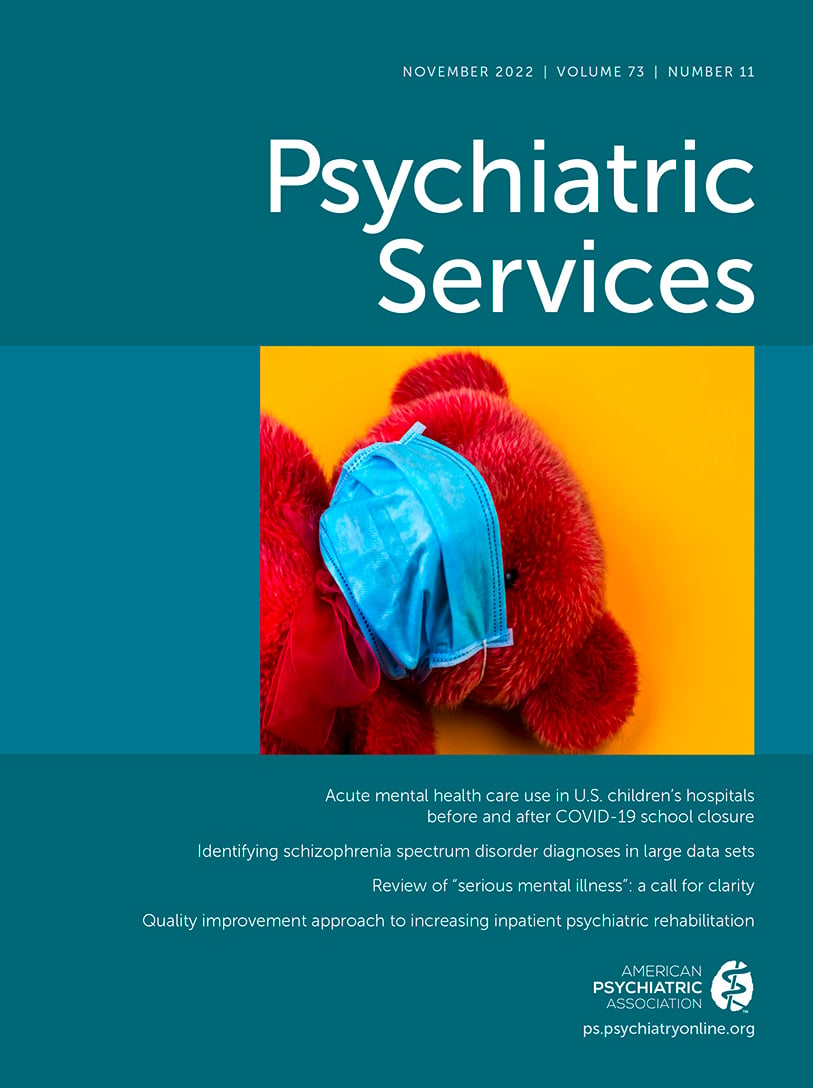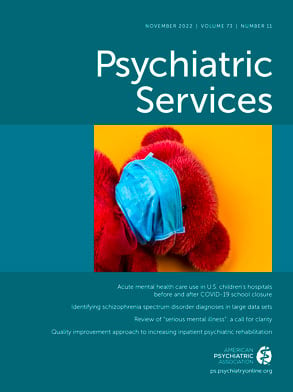Pharmacists may be able to make a valuable contribution to ameliorating public health risks among individuals with psychiatric disorders. Use of medications is commonplace in the treatment of patients who have psychiatric disorders. When used optimally and adhered to regularly, medications for psychiatric disorders can profoundly improve the symptom control and functional status of the patients who take them. However, medications for psychiatric disorders are also commonly associated with problems such as adverse effects, drug interactions, medication complexity, hospitalizations, emergency department visits, and increased costs (
1).
Pharmacists commonly see patients with psychiatric disorders in daily practice but are often hesitant to engage in relationships with them (
2). Pharmacists have also been shown to have lower levels of confidence in providing services to patients with psychiatric disorders than to those with other conditions (
3). Thus, pharmacists have tended to less frequently provide care to patients with psychiatric disorders, including provision of psychotropic medication education, disease-monitoring information, and identification of drug-related problems (
4). Yet, when pharmacists are equipped with information and skills that reduce stigma and increase literacy about psychiatric disorders, this gap in care provision is significantly narrowed (
5).
Psychiatric disorders and opioid use commonly co-occur. Adults with psychiatric disorders receive >50% of all opioids distributed in the United States annually, despite making up approximately 16% of the population (
6). Thus, patients with psychiatric disorders show a significant overlap with those filling an opioid prescription in the pharmacy setting. Pharmacists’ hesitance to provide care for patients with co-occurring opioid use and psychiatric disorders may impose a double burden—increasing the risk for problems related to psychiatric medications as well as those related to opioids. This hesitance may also represent a missed opportunity for pharmacists to provide important care and education in order to prevent opioid-related harms, including accidental overdose, misuse, and dependence. Individuals with psychiatric disorders have a higher risk for prescription drug misuse than persons without such disorders (
7). Therefore, information related to the identification of risk factors and steps to prevent misuse and overdose, as well as intervention when misuse is identified, is crucial for this patient population. Every opioid prescription must cross the hands of a pharmacist, ideally positioning community pharmacists for providing education and helping to reduce misuse or overdose risk among patients with psychiatric disorders who fill opioid prescriptions.
The Opioid and Naloxone Education (ONE) Program
We developed and implemented the ONE program (formerly known as ONE Rx), a statewide program for pharmacists in North Dakota, with the sole intent of addressing the opioid crisis, not to directly target pharmacists’ care for patients with psychiatric disorders. We wanted to equip pharmacists with the means to screen for risk of opioid misuse and accidental overdose among patients filling an opioid prescription in a community pharmacy setting and then to perform risk-appropriate interventions (
8). The ONE program was initiated in October 2018 and continues to this day. It is associated with opioid safety impacts such as increased distribution and acceptance of the opioid overdose–reversal medication naloxone, increased opioid partial filling (reducing the overall opioid supply dispensed from the pharmacy), increased patient education about opioid use disorder and medication take-back options, and reduced stigma among pharmacists toward patients who misuse opioids. After examining data from the ONE program, we realized that we could further analyze the data to help us understand how this program could aid pharmacists in helping people with mental illness and opioid use disorder. This column describes what we learned from reviewing these data and how our findings may inform future efforts to advance patient care provided by pharmacists.
The ONE program included pharmacist training that focused on opioid use disorder as a disease, stigma reduction and nonjudgmental communication approaches, opioid and naloxone pharmacologies, naloxone administration, logistical and legal steps associated with naloxone prescription, and patient education about opioids and naloxone. Pharmacists were also trained to use a patient intake form as a screening tool to ascertain patient-level opioid misuse risk. The screening tool assesses the risks for opioid misuse and accidental overdose. Opioid misuse risk is measured by a score generated from the Opioid Risk Tool (ORT) (
9), and risk of accidental overdose is determined by indication of one or more of the listed comorbid conditions, behavioral factors (e.g., current alcohol use), and medication regimens (e.g., benzodiazepine prescription). Pharmacists utilizing the ONE program were directed to use the screening tool for every patient filling a new opioid prescription and to readminister it every 6 months to patients who are on prolonged opioid treatment. Psychiatric conditions, including but not limited to depression, anxiety, bipolar disorder, schizophrenia, and current or past substance use disorder, are allotted risk values in the ORT. Treatments, including antidepressants and benzodiazepines, for some of these conditions are known to contribute to increased opioid overdose risk. Thus, the screening tool serves as a method to objectively identify people with a psychiatric disorder and signals to the pharmacist which patients may benefit from a focused intervention.
Pharmacists were trained to implement a set of interventions tailored to each patient on the basis of the screening results through an intervention triage tool. The interventions included those that are critical for patients identified as being at risk for opioid overdose or misuse, as well as interventions that were risk independent and applicable to all patients filling an opioid prescription (standard interventions). Critical interventions included discussing opioid use disorder, educating the patient about the benefits and availability of naloxone, dispensing naloxone, contacting the prescriber with concerns, referring the patient to community support services, and discussing risk factors for opioid overdose. Standard interventions included discussing medication disposal and offering the patient the option to partially fill the opioid prescription. Screened patients were deemed to be at risk if their ORT score (range 0–26) was ≥8 or if they had one or more risk factors for accidental overdose.
What We Learned
After 33 months of ONE program operation, 8,217 patient screenings had been conducted with the ORT. In a significant portion of these screenings, the patient reported >1 psychiatric disorder; there were 1,500 (18.3%) reports of depression, 577 (7.0%) reports of substance use disorder, and 460 (5.6%) reports of a psychiatric disorder other than depression. Patients reporting a history of depression during screening were greater than four times more likely to be identified as being at risk for accidental overdose or opioid misuse than were patients without a history of depression (43.3% [N=1,500] vs. 14.8% [N=6,717], respectively; odds ratio [OR]=4.38, 95% confidence interval [CI]=3.81–4.96).
Collectively, patient encounters involving one or more of a history of depression, substance use disorder, or other psychiatric disorder (N=1,980; 24.1% of the entire sample) resulted in those patients being more than twice as likely to receive at least one critical intervention from a pharmacist than those who did not report a psychiatric disorder (OR=2.46, 95% CI=2.19–2.72). Patient screenings indicating a medical history of substance use disorder, depression, or other psychiatric disorder resulted in those patients being 3.1 times, 2.5 times, and 2.1 times more likely, respectively, to receive at least one critical intervention from the pharmacist than those without these conditions.
Reflections on Impact and Future Possibilities
Negative impacts of the COVID-19 pandemic on psychiatric disorders, opioid use disorder, and overdose rates indicate that a significant overlap of opioid use and psychiatric conditions will likely persist for some time. Up to now, pharmacists have been thought of as gatekeepers to opioid-based medications, but they have not typically been immersed in the landscape of prevention efforts or first-line intervention when it comes to opioid use in the vulnerable population of patients with psychiatric disorders. Pharmacists providing opioid risk screening through the ONE program are delivering interventions at a higher rate to this group of individuals. Thus, the ONE program represents a promising approach to elevate the level of care for patients in this population. The ONE program screening process not only assists with detection of risk for opioid-related harms, but also appears to be associated with pharmacists more frequently providing education and other critical interventions to patients with a psychiatric disorder. The positive impacts associated with the ONE program are catching on—it was originally implemented in North Dakota but is already expanding to West Virginia and has the potential to be implemented and effective in several other states.
We do not know whether the growth in pharmacist interactions with patients with psychiatric disorders was due to the ability of pharmacists to use objective data to evaluate risk and triage care according to the risk levels identified. Anecdotally, some ONE program pharmacists stated that it was easier to have focused, albeit sometimes difficult, conversations with patients when a patient’s responses to the screening questions indicated the presence of risk. Pharmacists felt that the standard use of a patient-reported screening tool allowed patients to see pharmacists as providing care where it was needed rather than as “profiling” and thus stigmatizing patients. It is also possible that pharmacists felt more comfortable working with patients who have psychiatric disorders because of the training the pharmacists had received in nonjudgmental and stigma-free communication approaches. Consequently, pharmacists might have felt better equipped to try to empathize with patients with these disorders and might have been more comfortable approaching them to share information or ask questions. These hypotheses deserve further consideration, as does the fact that the ONE program still shows gaps in pharmacist care provision. For example, screened patients whose ORT or accidental opioid overdose risk score indicated an elevated risk should have received interventions from the pharmacist, yet approximately 20% (N=1,653) of these patients did not receive any intervention. We do not yet know the reasons for this gap in care provision, but it presents an opportunity for future evaluation. In addition, we did not assess whether initiating conversations about opioids improves pharmacist interventions pertaining to other medications, especially psychiatric medications. Previously published examples of pharmacists using a screening tool in the community pharmacy setting, including the 9-item Patient Health Questionnaire, have illustrated that such use may lead to additional interventions and engagement with the patient (
10).
Conclusions
We think it is worthwhile to explore whether, with additional objective screening tools or modified versions of the tool used in the ONE program, pharmacists can be better equipped to engage with patients who have psychiatric disorders and to provide tailored interventions to them, regardless of whether the patients are prescribed an opioid. On the basis of what we learned, we intend to continuously improve the program by evaluating whether use of a screening tool to gather patients’ experiences with their psychiatric medications can increase pharmacists’ likelihood of discussing psychiatric medication–related problems and providing relevant interventions. We plan to build on our learning to develop and evaluate additional tools and methods to further encourage pharmacists to provide valuable care in their communities.

